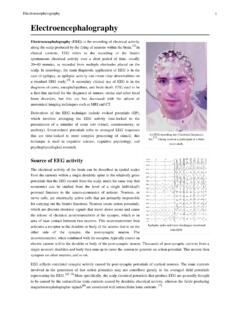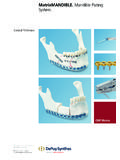Transcription of Introduction to MRI data processing with FSL
1 Introduction to MRI data processing with FSLAnna Blazejewska FMRIB = Functional magnetic resonance imaging of the Brain @ Oxford since 2000, last stable FSL , free! for structural MRI, functional MRI (task, resting), diffusion MRI data processing & analysisFSL = FMRIB Software Library written in C++ & TCL for Linux (virtual box on Windows) & Mac OS GUI but also command line!! shell script pipelines installation: support: wiki, FAQ, forum yearly FSL courses: theory & hands on, 5 days, slides on- N How Seminar Martinos Center March 30, 2017 Anna Blazejewska general: fslmaths, fslchfiletype, fslroi, smoothing, stats, fslviewand overviewstructural MRI registration.
2 Linear (FLIRT) & non-linear (FNIRT) brain segmentation/extraction (BET) tissue type segmentation (FAST) subcortical structures segmentation (FIRST) voxelwiseGM density analysis (FSLVBM) atrophy estimation (SIENA)functional MRI motion correction (MCFLIRT) EPI distortion correction (FUGUE, PRELUDE) model-based analysis (FEAT) model free ICA-based analysis (MELODIC) Bayesian analysis of perfusion, ASL data (FABBER, VERBENA, BASIL)diffusion MRI distortion correction (TOPUP) eddy current correction (EDDY) diffusion toolbox (FDT) tract-based spatial statistics (TBSS)Why N How Seminar Martinos Center March 30, 2017 Anna Blazejewska general: fslmaths, fslchfiletype, fslroi, smoothing, stats, fslviewand overview$ scripts!
3 Structural MRI registration: linear (FLIRT) & non-linear (FNIRT) brain segmentation/extraction (BET) tissue type segmentation (FAST) subcortical structures segmentation (FIRST) voxelwiseGM density analysis (FSLVBM) atrophy estimation (SIENA)functional MRI motion correction (MCFLIRT) EPI distortion correction (FUGUE, PRELUDE) model-based analysis (FEAT) model free ICA-based analysis (MELODIC) Bayesian analysis of perfusion, ASL data (FABBER, VERBENA, BASIL)diffusion MRI distortion correction (TOPUP) eddy current correction (EDDY) diffusion toolbox (FDT)
4 Tract-based spatial statistics (TBSS)Why N How Seminar Martinos Center March 30, 2017 Anna Blazejewska brain extraction = skull stripping goal: automatic segmentation of brain & non-brain tissue (skin, skull, eyeballs, etc.) preparation for: registration/motion correction tissue segmentation masking out non-brain problems of manual segmentation: time, training, reproducibility benefits of BET 5-20 sec, high reproducibility different contrasts T1-/T2-/T2*-w data, robust to bias field (uses local intensity changes) can estimate inner & outer skull & outer scalp surface1.
5 SegmentationSmith, SM, Fast robust automated brain extraction, HBM 17(3), , M et al.,BET2: MR-based estimation of brain, skull and scalp surfaces,OHBM, N How Seminar Martinos Center March 30, 2017 Anna Blazejewska how does it work?histogram-based threshold t estimationt-based binarizationcenter of gravity (COG)spherical surface initializationsurface = mesh of connected triangles(no folds, not cortex)subdividing each triangleexpanding the surfacevertex locations updated based on local intensitiesnot self-intersectingsurface smoothness conditionSmith, SM, Fast robust automated brain extraction, HBM 17(3), segmentationWhy N How Seminar Martinos Center March 30, 2017 Anna Blazejewska how to use it?
6 $ bet input output [parameters]-f <f> -g <g> f brain outline estimate, [0,1], = g brain outline bottom, top, [-1,1], =07T Philips MPRAGE mm3default: f= g=0 modified: f= g= segmentationWhy N How Seminar Martinos Center March 30, 2017 Anna Blazejewska <x y z>-r <r>initial center of gravity [voxels]head radius [mm], initial r/2robust brain center estimationtemporary add slices for small z-FOVapply to 4D fMRI data (-f + dilation)-R-Z-F-m-s-o-n-Asave binary brain masksave skull imagesave brain surface outlineskip segmented brain imagegenerate skull & scalp surfaces (BETSURF)$ bet input output [parameters]BET: how to use it?
7 1. segmentationWhy N How Seminar Martinos Center March 30, 2017 Anna Blazejewska tissue segmentationFMRIB s Automated Segmentation Tool goal: automatic segmentation of WM, GM & CSF input: BET processed images (extracted brain) single image: T1, T2, PD multichannel images pre-aligned (with FLIRT) output: binary tissue masks or probability maps Zhang,Yetal.,SegmentationofbrainMRimages throughahiddenMarkovrandomfieldmodelandt heexpectation-maximizationalgorithm,IEEE T ransMedImag,20(1), : uses Gaussian mixture model & removes bias voxel s neighborhood robust to of prior tissue probability maps Why N How Seminar Martinos Center March 30, 2017 Anna Blazejewska histogram as a mixture of Gaussians data intensity histogram model = mixture of Gaussians separation of the peaks segmentation peaks overlap segmentation more difficult for each voxel calculates.
8 P(CSF), P(GM), P(WM) WMGM/WM borderP(CSF) = 0P(GM) = 400P(WM) = 9000 segmentationWhy N How Seminar Martinos Center March 30, 2017 Anna Blazejewska hard segmentation vs probability maps7T Siemens MEMPRAGE mm3originalimage3 class segmentationCSFGMWM probability maps1. segmentationWhy N How Seminar Martinos Center March 30, 2017 Anna Blazejewska bias field correction low resolution, head motion, noise, blurring & bias field histogram peaks overlap RF inhomogeneity spatial intensity variations = bias field estimated bias fieldcorrected imageoriginal segmentationWhy N How Seminar Martinos Center March 30, 2017 Anna Blazejewska local neighborhood information robust to noiseFAST.
9 Neighborhood =0 = = = P(class) = P(intensity) + P(neighborhood) controls contribution of neighbors vs intensity, can be set by user1. segmentationWhy N How Seminar Martinos Center March 30, 2017 Anna Blazejewska how to use it?$ fast [options] inputsave estimated bias fieldsave bias-corrected input imageno bias field correctionnumber of iteration for bias field removal, =4bias field smoothing FWHM, =20mm-b-B-N-I-l , = data type: 1=T1, 2=T2, 3=PDnumber of input data channels, =1-H-t-Snumber of tissue type classes, =3save a binary mask for each classskip probability maps-n-g-nopve1.
10 SegmentationWhy N How Seminar Martinos Center March 30, 2017 Anna Blazejewska use of priorsuse prior probability maps for initialization (requires transformation to standard space)use prior probability maps at all stages (requires a/-A)alternative prior images for tissue classesinitial tissue-type means-a p1 p2 p3-s mean1. segmentationWhy N How Seminar Martinos Center March 30, 2017 Anna Blazejewska registrationregistration2. registration=transformation of 3D volumes into the same space (coordinate system)1. transformation 2.




